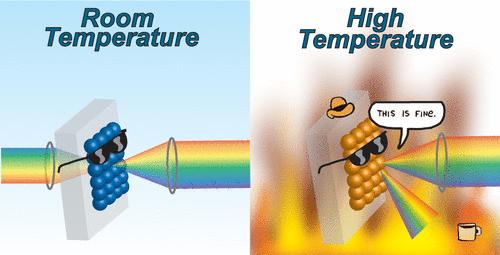当前位置:
X-MOL 学术
›
ACS Photonics
›
论文详情
Our official English website, www.x-mol.net, welcomes your
feedback! (Note: you will need to create a separate account there.)
Modulation of the Visible Absorption and Reflection Profiles of ITO Nanocrystal Thin Films by Plasmon Excitation
ACS Photonics ( IF 6.5 ) Pub Date : 2020-03-31 , DOI: 10.1021/acsphotonics.9b01825 Michelle A. Blemker 1 , Stephen L. Gibbs 2 , Emily K. Raulerson 1 , Delia J. Milliron 2 , Sean T. Roberts 1
ACS Photonics ( IF 6.5 ) Pub Date : 2020-03-31 , DOI: 10.1021/acsphotonics.9b01825 Michelle A. Blemker 1 , Stephen L. Gibbs 2 , Emily K. Raulerson 1 , Delia J. Milliron 2 , Sean T. Roberts 1
Affiliation

|
Heavily doped metal oxide nanocrystals (NCs) possess tunable infrared localized surface plasmon resonances (LSPRs) that give them utility for several potential applications, including photothermal therapy, smart electrochromic windows, photocatalysis, and optical gating. However, studies of the photoresponse of these materials have largely been limited to the short-wave infrared (SWIR) spectral region, where their LSPR response peaks. Little has been done to study how LSPR excitation modulates the optical properties of these materials around their band gap in the UV/visible region. Here we demonstrate changes in the optical absorption and reflectivity of Sn-doped In2O3 (ITO) nanocrystal thin films following LSPR excitation. SWIR irradiation of ITO NCs substantially heats their free charge carriers, altering the NC film’s dielectric response. This gives rise to an ultrafast increase in film reflectivity and absorptivity that relaxes within 1 ps following photoexcitation as hot charge carriers thermalize with the NC lattice. Using a model that accounts for free charge carrier behavior according to the Drude model as well as Fermi–Dirac statistics, we reproduce this behavior and predict that reflectivity changes of ∼6% can be achieved via sufficient SWIR irradiation of ITO NC films. We also apply our model to other common plasmonic materials, highlighting that plasmonic metal oxide NC films can be used to obtain large, spectrally flat reflectivity changes throughout the visible region. Our results suggest these materials hold potential for use as terahertz optical gates and further our fundamental understanding of their plasmonic behavior.
中文翻译:

等离子体激发对ITO纳米晶薄膜可见吸收和反射特性的调节
重掺杂的金属氧化物纳米晶体(NCs)具有可调谐的红外局部表面等离子体激元共振(LSPR),使其可用于多种潜在应用,包括光热疗法,智能电致变色窗,光催化和光学选通。但是,对这些材料的光响应的研究在很大程度上局限于短波红外(SWIR)光谱区域,在该区域其LSPR反应达到峰值。关于LSPR激发如何调节这些材料在紫外/可见光区域的带隙周围的光学特性,研究工作很少。在这里,我们展示了掺杂Sn的In 2 O 3的光吸收和反射率的变化LSPR激发后的(ITO)纳米晶体薄膜。ITO NC的SWIR辐照极大地加热了其自由电荷载流子,从而改变了NC膜的介电响应。随着热电荷载流子随NC晶格热化,这会导致薄膜反射率和吸收率的超快增加,在光激发后1 ps内松弛。使用根据Drude模型以及Fermi-Dirac统计来解释自由电荷载流子行为的模型,我们重现了此行为,并预测通过ITO NC膜的充分SWIR辐照可以实现约6%的反射率变化。我们还将模型应用于其他常见的等离子体材料,强调等离子体金属氧化物NC膜可用于获得整个可见光区域的大的,光谱平坦的反射率变化。
更新日期:2020-03-31
中文翻译:

等离子体激发对ITO纳米晶薄膜可见吸收和反射特性的调节
重掺杂的金属氧化物纳米晶体(NCs)具有可调谐的红外局部表面等离子体激元共振(LSPR),使其可用于多种潜在应用,包括光热疗法,智能电致变色窗,光催化和光学选通。但是,对这些材料的光响应的研究在很大程度上局限于短波红外(SWIR)光谱区域,在该区域其LSPR反应达到峰值。关于LSPR激发如何调节这些材料在紫外/可见光区域的带隙周围的光学特性,研究工作很少。在这里,我们展示了掺杂Sn的In 2 O 3的光吸收和反射率的变化LSPR激发后的(ITO)纳米晶体薄膜。ITO NC的SWIR辐照极大地加热了其自由电荷载流子,从而改变了NC膜的介电响应。随着热电荷载流子随NC晶格热化,这会导致薄膜反射率和吸收率的超快增加,在光激发后1 ps内松弛。使用根据Drude模型以及Fermi-Dirac统计来解释自由电荷载流子行为的模型,我们重现了此行为,并预测通过ITO NC膜的充分SWIR辐照可以实现约6%的反射率变化。我们还将模型应用于其他常见的等离子体材料,强调等离子体金属氧化物NC膜可用于获得整个可见光区域的大的,光谱平坦的反射率变化。











































 京公网安备 11010802027423号
京公网安备 11010802027423号